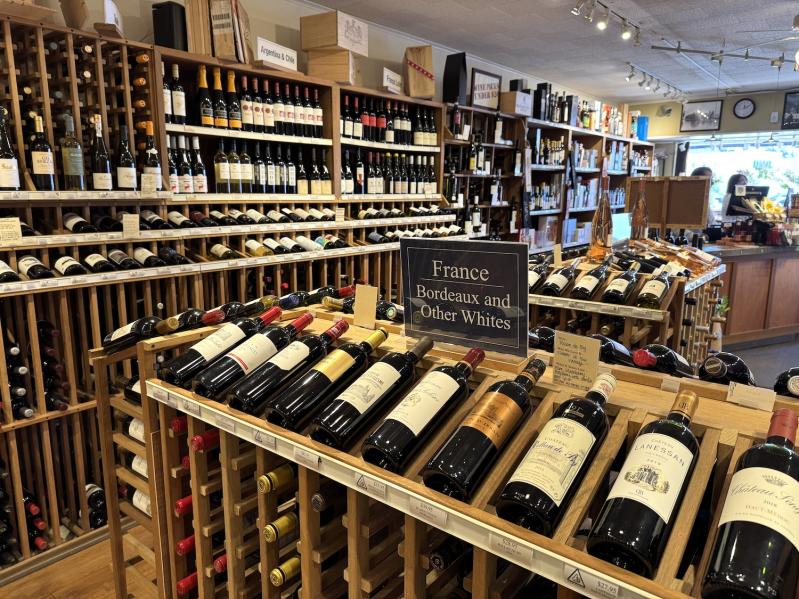Two weeks ago, President Trump threatened a 200-percent tariff on wine and other alcohol imports from Europe. The hikes were scheduled starting April 2, a day the president has taken to calling, “Liberation Day,” when the United States would send all trading partners lists of reciprocal tariffs.
How did we get here? First, the United States imposed a 25-percent tariff on European Union imports of steel and aluminum, which caused the E.U. to retaliate with a 50-percent reciprocal tariff on American whiskeys. The whiskey tariffs have been put off until mid-April so it’s not clear when, or if, President Trump’s European alcohol tariff will ever go live. Nonetheless, the threat is looming over South Fork wine and liquor retailers, who have been forced to react to the uncertainty.
Roman Roth, a winemaker and partner at Wolffer Estate Vineyard in Sagaponack, said he had just returned from ProWein, an international wine and spirits trade fair, held annually in Dusseldorf, Germany, and tariffs were an unavoidable conversation topic.
Some European importers, afraid that they’ll be placing crates with bottles in them in shipping containers that will be halfway across the Atlantic when tariffs are implemented, have simply stopped shipping. Others have sped up shipments in a race to beat what they think are inevitable price increases.
“There was a very somber mood because of the tariff threats,” Mr. Roth said. “If you have to keep your steel industry in business, for example, to combat China, who is subsidizing a whole business, they [tariffs] might make sense. But wine? I don’t see any benefit from tariffs for anybody.”
“Most of my importers are saying they have enough supply to last through June,” said Jacques Franey, the owner of Domaine Franey Wines and Spirits in East Hampton. “We’d start seeing the effects in the summer season, which is terrible. If 200 percent goes into effect, there won’t be any products coming from Europe. It’s going to kill a store like mine. Probably 75 percent of our product comes from Europe. The consumer is the one who is going to suffer.”
Heidi Schmitz, a co-owner of the Sag Harbor Liquor Store with her sister, Hilary, said “There’s definitely been a spike in sales of imported wines and chatter about the tariffs for sure. Not just amongst our customers, but suppliers, distributors, and sales reps. Our French and Italian wines were hot this past weekend.”
The wine and liquor industry was already pressured by Ozempic and a generational shift in drinking habits, in part due to the rise of legalized recreational marijuana, said Chris Miller, who is in charge of strategy, sourcing, and purchasing for Park Place Wines and Liquors in East Hampton Village. A three-decade veteran of the industry, he said the tariffs are “craziness.”
If implemented, retailers said a $15 bottle of Prosecco could rise to $45. A bottle of wine priced at $20 now, could sell for over $50. It all depends on how big the tariffs are and how much of the cost is eaten along the supply chain. While wine from France and Italy would obviously be affected, the tariffs would also apply to brandies, Irish whiskey, Cognac, Champagne, many popular vodkas, the most popular gin brand, Tanqueray, and Scotch whiskey.
“We’re kind of in limbo right now,” said Mr. Miller. “It’s bad for the industry all around. We think we’re going to have to change some things if big tariffs come through, but hopefully these are just threats and things calm down.”
Tariffs would not simply affect the liquid inside the bottles. The bottles themselves, the corks used to seal the bottles, the barrels that store the wine, and labels affixed to the bottles, would all rise in price.
“Yes, my number-one vodka is Tito’s,” said John Grisch, who owns Race Lane Wine and Liquor, “but Grey Goose is from France.” Smirnoff is owned by a United Kingdom company, Ketel One is from the Netherlands and Absolut and Svedka are from Sweden. Like Mr. Miller, he is a 30-year industry veteran, and has lived through industry challenges. “Still, there is zero in my experience that would even come close to a 200-percent tariff. Nothing.”
“Low-end Burgundies and Bordeaux are the majority of what people buy and those will just go away,” Mr. Grisch continued. “Anything that is price-point driven, meaning $50 and under, will be affected. Why would you spend $50 on a $20 European bottle of wine when you can buy a $50 Argentinian wine that is spectacular?”
Like others, he said local wines are great and have an important market niche, but they’re not enough to fill the void that would be created by the loss of European imports. American vintners would be affected negatively too, not just from price hikes on imported supplies, but also in more subtle ways involving wine culture.
“You can find some comparable products in the United States, but there will be less choice,” said Mr. Miller. “When South Africa came out of apartheid and the boycotts were lifted, their wines were inexpensive, but the quality wasn’t there. They lost out on viticulture techniques. If tariffs hit, we won’t be able to bring in the smaller, artisanal wines, and that’s the interesting stuff.”

